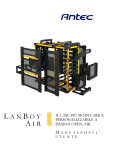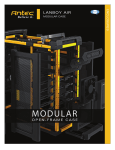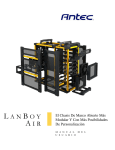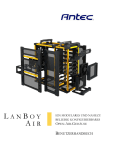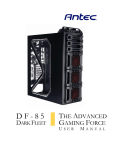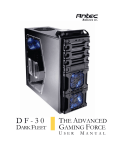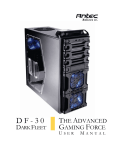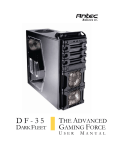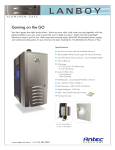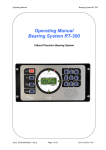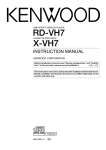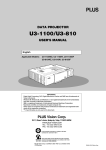Download Antec LanBoy Air Blue
Transcript
LANBOY AIR THE MOST MODULAR, MOST CUSTOMIZABLE OPEN-AIR CHASSIS USER MANUAL LANBOY AIR USER’S MANUAL Congratulations on your purchase of the Antec LanBoy Air. The LanBoy Air is the most modular, most customizable open-air chassis. Nearly every part on this chassis, down to the motherboard and PSU mounts, is removable and customizable. The LanBoy Air’s cooling system allows up to 15 inward-facing fans to create positive internal air pressure, blowing dust and heat out through its panel perforations. Up front, the ground-breaking AirMount™ HDD system literally suspends drives in mid-air for unsurpassed vibration and noise reduction. With thousands of different possible configurations, two internal 2.5” SSD bays and a front-panel USB 3.0 port, the LanBoy Air is perfect for building just one type of computer: Yours. The LanBoy Air comes without a power supply. Make sure you choose a power supply that is compatible with your computer components and has a long enough power harness to reach your motherboard and peripheral devices. We recommend our High Current, Signature Series, TruePower Quattro or TP New power supplies for the latest ATX specification compliance, broad compatibility, and power savings capability. At Antec, we continually refine and improve our products to ensure the highest quality. As such, your new chassis may differ slightly from the description in this manual. This isn't a problem; it's simply an improvement. As of the date of publication, all features, descriptions, and illustrations in this manual are correct. Disclaimer This manual is intended only as a guide for Antec’s computer enclosures. For more comprehensive instructions on installing the motherboard and peripherals, please refer to the user’s manuals that come with those components. 2 TABLE OF CONTENTS SECTION 1: INTRODUCTION 1.1 1.2 1.3 1.4 Getting to Know your Chassis .................................................................................. 5 Chassis Specifications ................................................................................................. 6 Included Screws ........................................................................................................... 6 Before you Begin ......................................................................................................... 7 SECTION 2: HARDWARE INSTALLATION 2.1 2.2 2.3 2.4 2.5 2.6 2.7 2.8 Setting up ...................................................................................................................... 9 Internal 3.5” Device Installation using AirMount™ ............................................. 10 External 5.25” Device Installation ............................................................................ 10 Internal 2.5” Device Installation ............................................................................... 11 Removing and Relocating the Motherboard/PSU ................................................. 13 Motherboard Installation ........................................................................................... 15 Power Supply Installation .......................................................................................... 17 Cable Management...................................................................................................... 17 SECTION 3: FRONT I/O PORTS 3.1 3.2 3.3 3.4 3.5 3.6 USB 2.0 ......................................................................................................................... 19 USB 3.0 ......................................................................................................................... 19 AC’97 / HD audio ports ............................................................................................ 19 Front Panel Ground Wire Installation ..................................................................... 20 Power Switch / Reset Switch / Hard Disk Drive LED Connectors .................. 20 Rewiring Motherboard Header Connections .......................................................... 21 SECTION 4: COOLING SYSTEM 4.1 4.2 4.3 4.4 4.5 3 Included Fans............................................................................................................... 23 Rear/Side 120 mm TwoCool™ LED Fans ............................................................ 23 Front 120 mm LED fans with Variable Speed Control ........................................ 24 Optional Fans .............................................................................................................. 25 Water Cooling .............................................................................................................. 25 SECTION 1 4 INTRODUCTION 1.1 GETTING TO KNOW YOUR CHASSIS 12 5 1 6 8 10 13 2 9 7 11 3 Drive Bays 1 5.25" drive bays default location 2 3.5" AirMount™ drive bays default location 3 2.5" internal SSD bay 4 Built-in toolbox for spare screws/parts Hardware Mounts 10 Removable motherboard tray 11 Removable power supply mount 12 Front I/O ports 13 8 expansion slots Cooling 5 2 x 120 mm top fan mounts and water cooling radiator fitting 6 1 x 120 mm rear TwoCool™ LED fan 7 2 x 120 mm front LED fans 8 2 x 120 mm TwoCool™ side LED fans 9 Water cooling grommets 5 4 CHASSIS SPECIFICATIONS 1.2 CHASSIS TYPE Mid Tower Yellow / Black Blue / Black Red / Black - 20.4” (H) x 8.7” (W) x 19.3” (D) - 517.5 mm (H) x 222 mm (W) x 490 mm (D) 20.3 lbs / 9.2 kg 2 x front variable-speed 120 mm LED fans 1 x rear TwoCool™ LED fan 2 x side 120 mm TwoCool™ LED fans to cool graphics cards 2 x CPU fan (optional) 6 x side drive bay fan (optional) 2 x top 120 mm fan (optional) Water cooling capable 6 x internal 3.5” 3 x external 5.25” 2 x internal bottom-mounted 2.5” SSD drive CHASSIS COLOR DIMENSIONS WEIGHT COOLING DRIVE BAYS 8 EXPANSION SLOTS MOTHERBOARD SIZE Mini-ITX, microATX, Standard ATX 1 x USB 3.0 2 x USB 2.0 AC’97 / HD Audio In and Out FRONT I/O PANEL INCLUDED SCREWS 1.3 The LanBoy Air is designed to be extremely flexible. A variety of screws are included to accommodate the multitude of configurations that are possible with this chassis. The included toolbox depicted in section 1.1 contains most of these screws. An inventory of all screws and intended usage and quantity is provided here: Screws included in the toolbox A A. B. C. D. E. F. G. H. 6 B C D E 5.25” external drive mounting screws (12) Motherboard mounting screws (9) Power supply mounting screw (4) AirMount™ 3.5” internal drive mounting screws (24) Optional top fan mounting screws (8) Motherboard standoffs (9; 6 preinstalled) Optional side fan mounting screws (10) 2.5” drive mounting screws (8) F G H Preinstalled screws I I. J. K. L. M. N. J K L M N Case thumbscrew (long) Case thumbscrew (short) Power supply mount release screw 5.25” drive rail mounting screw Rear panel screw Front panel /motherboard tray / PSU mount screw BEFORE YOU BEGIN 1.4 In order to ensure that your building experience with the LanBoy Air will be a positive one, please take note of the following: • While working inside your LanBoy Air, keep your chassis on a flat, stable surface. Make sure your build environment is clean, well-lit, and free of dust. • Antec chassis feature rounded edges that minimize the occurrence of hand injuries. Nonetheless, exercise caution and control when handling chassis interiors. We strongly recommend taking the appropriate time and care when working inside the chassis. Avoid hurried or careless motions. Please use reasonable precaution. • Handle components and cards with care. Do not touch the components or contacts on a card. Hold a card by its edges. Hold a component such as a processor by its edges, never by its pins. • To avoid electrostatic discharge, ground yourself periodically by touching an unpainted metal surface (such as a connector or screw on the back of this computer) or by using a wrist grounding strap. • Before you connect a cable, ensure that both connectors are correctly aligned and oriented. Bent pins can be difficult to fix and may require replacement of the entire connector. • This manual is not designed to cover CPU, RAM, or expansion card installation. Please consult your motherboard manual for specific mounting instructions and troubleshooting. Before proceeding, check the manual for your CPU cooler to find out if there are steps you must take before installing the motherboard. • Do not sit on your chassis. Although it is constructed of heavy-duty steel and internally reinforced, it is not designed to support the weight of an adult, and may buckle. • Remember to use the right tools for each task. Do not use improvised screwdrivers like coins, nails or knife blades as they may result in damage to screw threads or even injury. Do not use your fingernails to separate edges or lift the sides of the chassis, as paint chipping or injury may occur. Note: This manual is not designed to cover CPU, RAM, or expansion card installation. Please consult your motherboard manual for specific mounting instructions and troubleshooting. 7 SECTION 2 8 HARDWARE INSTALLATION SETTING UP 2.1 Note: The order in which hardware is installed in this manual is different from that of typical cases; this is due to the unique design of the LanBoy Air chassis. We recommend that you follow the order laid out in this manual, as it takes full advantage of the LanBoy Air’s features. 1. Put the chassis upright on a flat, stable surface so that the rear panel (power supply and expansion slots) is facing you. Remove the thumbscrews as depicted in Figure 1 on the right, and remove the corresponding thumbscrews from the other side. 2. Remove the larger panels by pulling them away from the chassis. Figure 1 – Side panel thumbscrews 3. Remove the smaller panels by rotating them outward slightly less than 180º (Figure 2), and pulling them off their hinges, starting with the bottom hinge. Figure Figure 2 – 2Rotate – Rotate smaller smaller panels panels outward to and remove the remove bottom hinge first 4. The LanBoy Air should now look like Figure 3. Figure 3 – LanBoy Air with side panels removed 9 INTERNAL 3.5” DEVICE INSTALLATION 2.2 Note: The next two sections cover installing 3.5” and 5.25” drives in their default locations, with 5.25” drives on top and 3.5” drives below them. The front fan mounts and drive bay covers can be removed and relocated to accommodate a number of different mounting configurations. The LanBoy Air utilizes Antec’s revolutionary AirMount™ suspension HDD mounting system. This system suspends hard drives in the drive bays, reducing vibration and subsequent noise. To mount drives using AirMount™: 1. Using four supplied AirMount™ screws (refer to section 1.3) and two AirMount™ mounting brackets (two are preinstalled in the case, additional brackets are included in a box inside the case), attach the hard drive mounting brackets to your hard drive, orienting them so that the bottom of the bracket is flush with the bottom of the hard drive (Figure 4). Figure 4 – AirMount™ bracket orientation 2. Determine the horizontal orientation of the drive you wish to use, and attach the mounting hooks to the attachment openings closest to the edges of the drive (Figure 5, Figure 6). Figure 5 – Forward-facing 3.5” drive Figure 6 – Sideways-facing 3.5” drive 3. 10 Mount any other 3.5” HDD devices accordingly. Note: If you are transporting the LanBoy Air, it is recommended that you remove any hard drives prior to transport. EXTERNAL 5.25” DEVICE INSTALLATION 2.3 There are three externally accessible 5.25” drive bays. Drives can be mounted in three possible horizontal orientations. 1. Unscrew and remove the drive bay cover in front of the drive bay in which you will be installing a drive. You will need to temporarily remove this cover even if you mounting a sideways-facing drive because you will need access to secure screws to the side of the drive. 2. Slide the mounting rails into the chassis, with the metal tabs pointing outward and towards the back (Figure 7). Secure the rails to the chassis with the provided screws. Make sure to install the mounting rails based on the orientation you would like to use. (Figure 8, Figure 9). Figure 7 – Insert 5.25” drive rails with tabs facing out 3. Figure 8 – Forward-facing rail orientation Slide the drive into the drive bay, and secure it to the mounting rails using four 5.25 external mounting screws (Figure 10, Figure 11). Figure 10 – Forward-facing drive 4. 2.4 Mount any other 5.25” devices accordingly. INTERNAL 2.5” DEVICE INSTALLATION The bottom of the LanBoy Air can accommodate up to two 2.5” SSD drives. To mount and install these drives: 11 Figure 9 – Sideways-facing rail orientation Figure 11 – Sideways-facing drive 1. Insert the rubber grommets into the mounting holes, with the larger portion of the grommet facing the top of the case (Figure 12). 2. Lay the LanBoy Air on its side, so you can access the outside bottom of the chassis. 3. Align the 2.5” drive with the mounting holes on the bottom of the chassis with the back of the drive facing the back of the chassis (Figure 13). 4. Secure the drive to the bottom of the chassis using the 2.5” drive mounting screws (Figure 13). REMOVING AND RELOCATING THE MOTHERBOARD/PSU 2.5 Figure 12 – 2.5” drive mounting grommets Figure 13 – Securing the 2.5” drive Both the motherboard tray and PSU mount are installed on rails inside the chassis and can be removed to make motherboard and PSU installation easier. In addition, the rails themselves can be relocated to accommodate topmounting the PSU. Removing the PSU Mount 1. 2. 3. Place the chassis upright, with the front facing right. Remove the left larger panel. Remove the thumb screw and pull the PSU tray out and put it aside (Figure 14, Figure 15). Removing the Motherboard Tray 1. 2. 3. Figure 14 Figure 15 Remove the five rear screws (Figure 16) and remove the back panel. Remove the three cable management ties attached to the back of the motherboard tray. Slide the motherboard tray towards the back, and out of the chassis (Figure 17). Figure 16 – Back panel screws Figure 17 – Removing the motherboard tray Note: If you do not need to change the location of the motherboard/PSU, you can now go directly to section 2.6 for motherboard installation. 12 4. 13 Remove the four screws holding the PSU mount in place. Lift and remove the mount, moving it towards the front of the chassis (Figure 18). Figure 18 – PSU mount screw locations 5. Working with the right side of the chassis, remove the two screws securing each of the rails that the motherboard slides on. Remove the rails by pulling on the side facing the front of the chassis first. (Figure 19). Figure 19 – Removing the motherboard tray rails 6. Install the rails in the lower slots indicated in Figure 20 and secure using the screws you just removed. Figure 20 – New rail positions 7. 14 Install the PSU mount at the top of the chassis, flipping the PSU mount and installing screws in the top and rear of the chassis. See Figure 21 for new screw locations. Figure 21 – PSU mount screw locations 8. Once you have secured the rails and PSU mount, the chassis should now look similar to Figure 22. Figure 22 2.6 MOTHERBOARD INSTALLATION Before proceeding: • • Check the manual for your CPU cooler to find out if there are steps you must do before installing the motherboard Make sure you have the correct I/O panel for your motherboard (Figure 23). If the panel provided with the chassis isn’t suitable, please contact your motherboard manufacturer for the correct I/O panel. Figure 23 – Make sure you have the correct I/O panel. This mismatched I/O panel can cause difficulties down the road. 15 Note: This section assumes that you have removed the motherboard tray in section 2.5. If you are installing a motherboard directly into the chassis, lay the chassis on its side with the drive mounts on the right. 1. With the motherboard tray on a flat surface, lay the motherboard on the tray and align it with the standoff holes on the motherboard tray and remember or mark which holes are lined up (Figure 23). Figure 23 – Motherboard tray with motherboard 2. Now remove your motherboard by lifting it up. 3. Install standoffs as needed (Figure 24) and put the motherboard back in. Figure 24 – Motherboard tray with preinstalled standoffs and additional standoff holes identified 4. Screw in your motherboard to the standoffs with the provided motherboard mounting screws (Figure 25). Caution: Make sure to remove any unused motherboard standoffs. They may come into contact with the back of the motherboard and may electrify your chassis exterior if left connected. Figure 25 – Screwing in the motherboard after standoffs are installed 16 9. Slide the motherboard tray halfway into the chassis along the rails. Connect your drive bay devices to the motherboard and then slide the motherboard tray the rest of the way into the chassis. Connecting devices when the motherboard tray is halfway in gives you more space to work with when you make the connections. Figure 26 – Reinserting the motherboard tray 10. Replace the rear panel and secure it using the original five screws. POWER SUPPLY INSTALLATION 2.7 1. Slide the PSU into the PSU mount and attach the PSU to the PSU mount with the screws provided (Figure 27) Figure 27 – PSU in mount with screws identified Note: Power supplies with fans on the bottom of the power supply will need to be mounted so that the fan is facing the top of the chassis, unless the power supply is installed in the top of the chassis. The LanBoy Air provides mounting holes for power supplies with standard mounting layouts to be installed right side up or upside down. 17 2. Insert the PSU mount with PSU into the chassis along the rails. Secure the PSU mount with the thumbscrew. 3. Connect the PSU connectors to your devices. CABLE MANAGEMENT 2.8 There is a cable management area between the motherboard tray and right side panel, as well as cable ties located on the back of the motherboard panel. You can tuck excess cables into this compartment. 1. With the front of the chassis facing left, remove the thumbscrews from the larger side panel, and remove the panel. You may also need to remove the smaller side panel, depending on the horizontal orientation of your drives. 2. Choose the cables you would like to pass through the open sections to behind the motherboard tray. Pull these cables through and secure them using the cable management ties. 3. Use the cable ties provided to hold your cables in place. Cable ties can be anchored to tiedown locations located on the back of the motherboard tray (Figure 28). Figure 28 – Cable management tiedown areas 18 SECTION 3 19 FRONT I/O PORTS 3.1 USB 2.0 Connect the front I/O panel USB cable to the USB header pin on your motherboard. Check your motherboard user’s manual to ensure that it matches the table below: 1 9 3.2 2 10 Pin Signal Names Pin Signal Names 1 USB Power 1 2 USB Power 2 3 Negative Signal 1 4 Negative Signal 2 5 Positive Signal 1 6 Positive Signal 2 7 Ground 1 8 Ground 2 9 Key (No Connection) 10 Empty Pin USB 3.0 There is a USB 3.0 connector in the front I/O panel. To use this connector, please refer to the instruction sheet included with the chassis. 3.3 AC’97 / HD AUDIO PORTS There is an Intel® standard 10-pin AC’97 connector and an Intel® 10-pin HDA (High Definition Audio) connector linked to the front panel of the chassis. Pin Signal Names (HDA) Pin Signal Names (AC’97) 1 MIC2 L 1 MIC In 2 AGND 2 GND 3 MIC2 R 3 MIC Power 4 AVCC 4 NC 5 FRO-R 5 Line Out (R) 6 MIC2_JD 6 Line Out (R) 7 F_IO_SEN 7 NC 8 Key (no pin) 8 Key (no pin) 9 FRO-L 9 Line Out (L) 10 LINE2_JD 10 Line Out (L) You can connect either the AC’97 or the HDA connector, depending on your motherboard. Locate the internal audio connectors from your motherboard or sound card and connect the corresponding audio cable. Consult your motherboard or sound card manual for the pin-out positions. Even if your system supports both standards, only use one connector. 20 3.4 FRONT PANEL GROUND WIRE INSTALLATION The LanBoy Air includes a grounding wire for the front panel ports. This wire should be attached to the chassis using one of the PSU screws, as depicted in Figure 29. Figure 29 – Attaching the front panel ground wire 3.5 POWER SWITCH / RESET SWITCH / HARD DISK DRIVE LED CONNECTORS Connected to your front panel are LED leads for power and HDD activity, as well as switch leads for the power and reset buttons. Attach these to the corresponding connectors on your motherboard. Consult your motherboard manual for specific pin header locations. For LEDs, colored wires are positive ( + ). White or black wires are negative ( – ). If the LED does not light up when the system is powered on, try reversing the connection. For more information on connecting LEDs to your motherboard, see your motherboard user’s manual. Figure 30 – Front panel leads Note: Polarity (positive and negative) does not matter for switches. 21 REWIRING MOTHERBOARD HEADER CONNECTIONS 3.6 There may come a time when you need to reconfigure the pin-out of a motherboard header connector. Examples could be for your USB header, audio input header, or some other front panel connector such as the Power Button connector. Before performing any work, please refer to your motherboard user’s manual or your motherboard manufacturer's website to confirm the pin-out needed for your connector. We strongly recommend making a notated drawing before beginning work so that you can recover if your work gets disturbed. Figure 31 – Front panel headers 22 1. Determine which wires you need to remove in order to rewire your plug to match the USB pin-outs on your motherboard (refer to your motherboard user’s manual). Working on one connector at a time, use a very small flathead screwdriver or similar tool to lift up on the black tab located beside the gold posts (squares). This will allow you to easily slide out the pins from the USB plug. 2. Working carefully so as not to damage the wires, connectors, or pins, slowly remove the pin from the connector. Repeat these steps for each wire you need to change. 3. Working carefully so as not to damage the wires, connectors or pins, slowly insert the pin into the correct slot of the connector then snap closed the black tab that was lifted in step 1. Repeat these steps for each wire you need to change. SECTION 4 23 COOLING SYSTEM 4.1 INCLUDED FANS C B A Standard fans on the LanBoy Air: A –2 x 120 mm front variable speed fans B – 2 x 120 mm side TwoCool™ fans C – 1 x 120 mm rear TwoCool™ fan 4.2 REAR/SIDE 120 MM TWOCOOL™ LED FANS The LanBoy Air comes with one rear and two side 120 mm TwoCool™ LED fans. These fans have a two-speed switch that lets you choose the speed best suited to your need. The rear fan switch is located on the rear panel and the side fan switches are attached to the fans. Figure 32 – Rear fan control panel 24 120MM FAN SPECIFICATIONS: Size: Rated Voltage: Operating Voltage: Speed High 1500RPM Low 900RPM 120 x 25mm two-speed fan 12V DC 10.8V ~ 13.2 V Input Current Air Flow 1.4m³ / min (51.2 CFM) 0.8m³ / min (30.1 CFM) 0.3A 0.2A Static Pressure 1.2 mm-H2O (0.05inch-H2O) 0.5 mm-H2O (0.02inch-H2O) Noise Input Power 27.9 dBA 3.6 W 16.9 dBA 2.2 W Note: The minimum voltage to start a typical TwoCool™ fan is 5V. We recommend that you set the fan speed to High if you choose to connect the fan(s) to a fan control device or to the Fan-Only connector found on some Antec power supplies. A fan control device regulates the fan speed by varying the voltage, which may start as low as 4.5V to 5V. Connecting a TwoCool™ fan set on Low to a fan-control device may result in the fan not being able to start because the already lowered voltage from the fan control device will be further reduced by the TwoCool™ circuitry below 5V. 4.3 FRONT 120 MM LED FANS WITH VARIABLE SPEED CONTROL The LanBoy Air comes with two 120 x 25mm LED fans which are preinstalled in front the chassis to cool the hard drives. Each fan comes with a speed control knob at the front of the faceplate. Turn the knob clockwise to increase the speed. The lowest speed is 1000 rpm, while the highest speed is 2000 rpm. 120 MM LED FAN SPECIFICATIONS: Size: Rated Voltage: Operating Voltage: Speed Highest 2000RPM Lowest 1000RPM 120 x 25mm speed control fan 12V DC 10.8V ~ 13.2 V Input Current 0.3A 0.2A Air Flow Static Pressure 1.9m³ / min (66.6 CFM) 0.94m³ / min (33.3 CFM) 2.6 mm-H2O (0.1inch-H2O) 0.6 mm-H2O (0.03inch-H2O) Noise 34.5 dBA 3.6 W 19.5 dBA 1.8 W Figure 33 – Fan speed adjustment knob 25 Input Power OPTIONAL FANS 4.4 The LanBoy Air can accommodate up to ten additional 120 mm fans in four different locations: 1. 2. 3. 4. Two additional fans can be mounted inside the left larger panel. Three fans can be mounted inside the left smaller panel Three fans can be mounted inside the right smaller panel Two fans can be mounted at the top of the chassis. C A B Optional fan mounts on the LanBoy Air: A –2 x 120 mm large side panel fans B – 6 x 120 mm small side panel fans (3 x per side) C – 2 x top 120 mm fans When installing optional top-mounted fans, use the top fan mounting screws identified in section 1.3. When installing optional side-mounted fans, use the side fan mounting screws identified in section 1.3. Note: 4.5 We recommend using Antec 120mm TriCool™ or TwoCool™ fans and setting the speed to Low. All fans bring cool air into the chassis, which creates positive air pressure, pushing heat and dust out of the chassis. WATER COOLING The LanBoy Air is water cooling-ready. Removing the rear handle at the top of the LanBoy Air allows a water cooling radiator to be installed. In addition, water cooling grommets have been provided at the back of the chassis to accommodate water cooling. Figure 34 – Water cooling grommets 26 Antec, Inc. 47900 Fremont Blvd. Fremont, CA 94538 tel: 510-770-1200 fax: 510-770-1288 Antec Europe B.V. Stuttgartstraat 12 3047 AS Rotterdam The Netherlands tel: +31 (0) 10 462-2060 fax: +31 (0) 10 437-1752 Technical Support: US & Canada 1-800-22ANTEC [email protected] Europe +31 (0) 10 462-2060 [email protected] www.antec.com © Copyright 2010 Antec, Inc. All rights reserved. All trademarks are the property of their respective owners. Reproduction in whole or in part without written permission is prohibited. 27




























